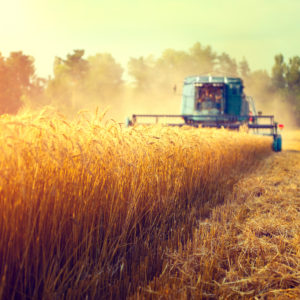The last century took Americans from the dawn of the automobile to the moon. It also took American agriculture from the horse and plow to increasingly specialized technology that allows a smaller population of farmers to feed an ever growing world. As the world population continues to grow, sustainable agriculture is becoming a more and more important focus both from international organizations like the U.N. and from consumers. As a result, agriculture in the U.S. and around the world is facing a variety of pressures, which policy makers are hoping to address on a variety of levels.
At a panel discussion hosted by the Washington Post on Monday, Weibe Draijer, the chairman of the board of Rabobank, a Dutch financial institution that is the world’s leading food and agricultural bank, announced a new program, “Kickstart Food,” to accelerate the transition to sustainable agriculture.
“We are kickstarting not only on the side of the earth, where the soil needs to be preserved and the arable land needs to be conserved, we are starting a program that has to do with nutrition, with the supply chain, and with waste,” he said. The program is a $1 billion initiative to boost environmentally sustainable and stable food production while decreasing waste.
Through the new fund, Rabobank wants to be able to help farmers experiment with new crops and sustainable agriculture techniques by offering insurances or loans to cushion them from the risks of crop failure. Both the bank and its partner, the U.N., want to find ways to better preserve the quality of soil while still increasing yields.
Increasingly, however, these sustainable agriculture goals are being complicated by a variety of outside factors, including concerns about biodiversity and climate change from sources outside of the agriculture industry.
“The World Wildlife Fund (WWF) has come to believe that how we produce food had greater impact on biodiversity than any other human activity,” said Jason Clay, Senior Vice President for Markets and Food at the WWF, who cited statistics that found that agriculture was tied to 70 percent of world-wide water use and 24 percent of greenhouse gas emissions.
At the same time, everyone needs to eat. Cutting back on food production is not a viable solution as global populations continue to rise. In this respect global agricultural trends begin to differ from those in the U.S., where consumers are increasingly interested in knowing where their food came from.
“Radical transparency is the new trend, so as much as these problems can be overwhelming, the consumer is moving forward. There has been double digit growth in the consumption of organic food,” said Errol Schwiezer, a former head of grocery for Whole Foods and co-founder of BeyondBrands, a company that helps new natural brands to launch.
These consumer pressures have already led to changes in how chicken and other meats are produced and may eventually spur new definition at the commodity market level. However, even with its recent growth, organic foods are a tiny portion of overall U.S. food expenditures. Last year, organic food accounted for just over 5 percent of all food sales.
If sustainable farming necessarily means organic farming, then achieving the production growth needed to feed the world in 2100 would make food much more expensive. It’s a reality that environmental advocates like Clay acknowledge.
“The price of food has got to go up, but already today most farmers can’t afford to feed their own families,” he said.
The experts say that the trouble is that today’s food prices reflect commodities markets, but not necessarily broader externalities including deforestation and climate change. For some of the advocates, this is where government needs to step in.
“The farmer can’t just raise the price of the corn that they’re selling that’s what makes these conservation efforts in the Farm Bill really critical,” said Rod Snyder, president of Field to Market. “It is policy that is going to move the needle on the ground for these very price controlled farmers.”
This could include programs to encourage the growth of different cover crops like peas and legumes to prevent erosion and provide animal feed. However, he and the other panel members felt that farmers needed additional ways to be introduced to new farming practices to promote sustainable agriculture.
At least in the U.S., many farmers are already embracing technology to hone their farm’s efficiency without harming soil quality and are skeptical of decisions made by far-off experts. Speaking from his combine while working his farm in Iowa, David Becker expressed his frustration with a top-down approach to agriculture, saying that in the field, some of these approaches only hurt efficiency.
“The public perception is that we’re strip mining our fields–that couldn’t be further from the truth,” he said, explaining how he used a variety of technologies to maintain the fertility of the soil, including soil samples, satellite imaging, and computerized fertilization equipment that allows him to carefully tailor how nutrients are spread across his fields.
“We don’t put on any more than our plants can use because we already spend thousands of dollars on fertilizers,” he said.
For Becker, who works the same fields his father and grandfather tilled, farmers are already driven by a search for best practices, and agricultural groups at the local level have been established to continue this education. As a result, farmers have adopted practices to not only use fertilizer more efficiently, but also changed how they till and plant to avoid soil loss through erosion.
“We do everything in our power to preserve the quality of our soil,” he said, “but we can’t be forced to do things that set us back. The goal is to feed the population. We’re doing more with fewer farmers than ever before because of the technology and seed varieties we have.”
“Don’t take away those tools,” he stressed.

